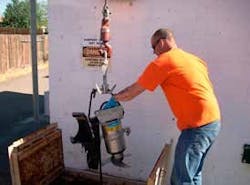The City of Reno, NV, has long battled the buildup of fats, oils, and grease in the wetwells of wastewater lift stations in the valleys within this high desert city. Recently, the city set out to address the problem and reduce the associated costs.
Scope
“Our enforcement people do a good job of preventing the release of restricted waste into the sewer lines in the core of Reno, where you find casinos, restaurants, and related tourist development,” said Tony Sallaberry, a sewer maintenance group supervisor. “We faced a much greater problem with grease in the lift stations serving residential areas and odorous sediments in the small lift stations of mountainous areas.”
Waste in the Reno lift stations could accumulate into six- to eight-inch-thick mats of solidified grease, paper, and rags, which interfered with the level control system resulting in false SCADA alarms. The problem was further aggravated by complaints about the associated odor. City environmental policy prohibits the use of additives and enzymes for wastewater treatment, so Sallaberry and his team were limited to mechanical methods.
“Until recently, we relied on a contractor with a vacuum truck to clean out the wetwells,” Sallaberry said. “We wanted to find an alternative.”
“In addition to the quarterly wetwell cleaning needed at our six or seven most troublesome stations, all were cleaned at least once a year,” said Ace Ariaz of the lift station crew. “It amounted to a significant expenditure.”
Solution
Instead of continuing the frequent wetwell cleanouts at 28 lift stations, Ariaz and Pete Galati of the local Flygt office tested an alternative.
Mixers are often used to create turbulence in clarifiers at wastewater treatment plants and in the high-sediment wastewater chain of industrial facilities. Ariaz selected a Flygt Model 4630 mixer to prevent buildup in the wetwell of a test station, which serves an area of mixed warehouse and housing customers.
Galati, the Flygt field manager recommended the 4630 because it delivers a powerful 460 Newtons of thrust. Flygt designed the unit with a cutter behind the 6-degree propeller that prevents stringy fibrous material from building up. A basic timer was set for the mixer to run for two minutes at half-hour intervals.
Result
After several months of testing, Sallaberry and his lift station workforce saw a significant reduction in man hours (8) and wet well cleaning charges ($700) per incident. Sallaberry was convinced that a submersible mixer was a practical means of keeping the solids and sediment churned up in the most problem-prone wetwells. Since 2008, additional Flygt model 4610, 4620, and 4630 mixers have been successfully added to several lift stations throughout the city to prevent debris buildup within the submersible pump lift stations.
“We noticed an immediate improvement in maintaining the 300-to 400-gpm flow at the test station and have had no problems there ever since,” Sallaberry said.
“We have since equipped several other stations with the same mixer, plus a smaller 155-Newton unit to handle 20-gpm stations in residential areas.”
After seven months, the two stations that were once the most problematic showed no indication of needing to be cleaned out. “We intend to add even more Flygt mixers as budget and time allow,” Sallaberry said.
Editor's Note: Scranton Gillette Communications and the SGC Water Group are not liable for the accuracy, efficacy and validity of the claims made in this piece. The views expressed in this content do not reflect the position of the editorial teams of Water & Wastes Digest, Water Quality Products and Storm Water Solutions.

